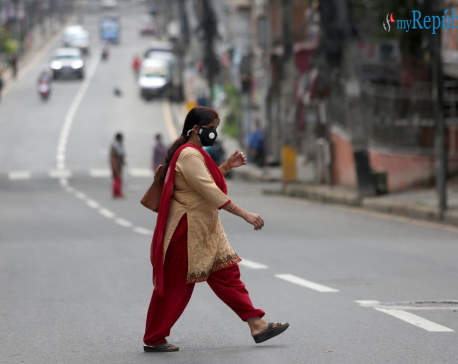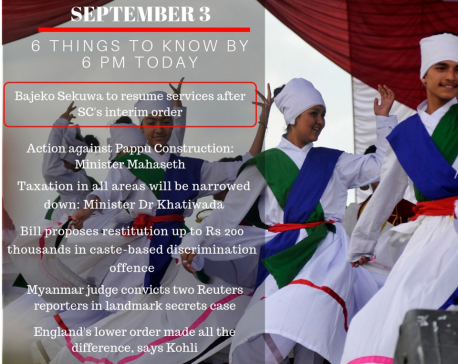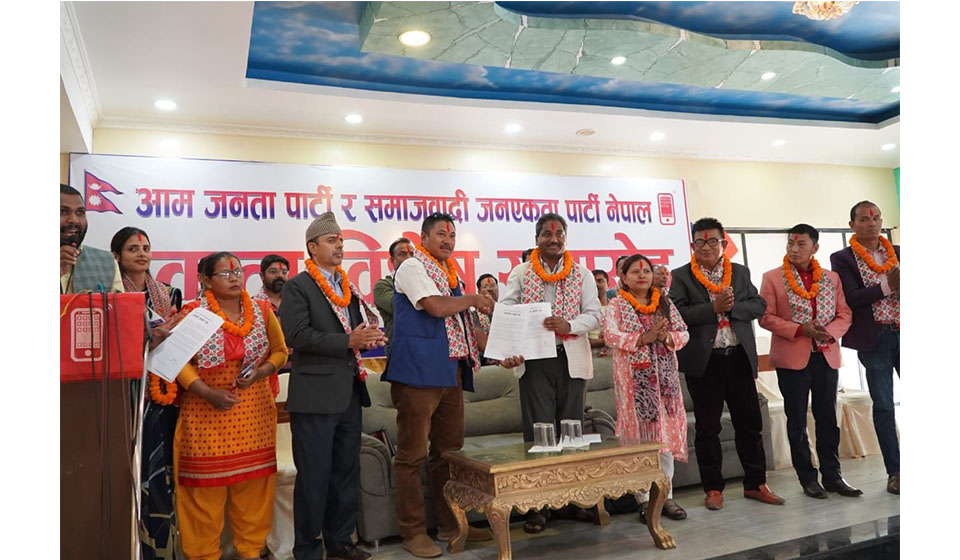
OR
Opinion
Inclusive Strategies for Disabilities in Nepali Politics
Published On: August 7, 2023 08:35 AM NPT By: Jalasa Sapkota

In the pursuit of a truly equitable and just society, it is essential to recognize the crucial role of marginalized communities in the political arena. Among these often overlooked communities are persons with disabilities (PWDs), who constitute a substantial segment of the global population. In Nepal, as in many countries worldwide, the rights and representation of persons with disabilities in politics have been limited, hindering their full integration into society and perpetuating systemic inequalities. However, in recent years, Nepal has taken commendable strides towards fostering inclusive representation and ensuring human rights for all, aligning its efforts with the principles and agenda of the Sustainable Development Goals (SDGs) and a human rights approach.
The SDGs and Human Rights Approach
The SDGs, launched by the United Nations, encompass a comprehensive vision of a prosperous, sustainable, and just world for all. Rooted in principles of equality, human rights, and social justice, the SDGs aim to address various global challenges, including those faced by marginalized groups such as persons with disabilities. As Nepal earnestly endeavors to achieve these goals, one critical area of focus lies in providing equal opportunities for political participation to all citizens, irrespective of their abilities or disabilities.
Recognizing the significance of inclusive representation, the Government of Nepal (GoN) has been actively formulating policies and strategies to address the marginalization faced by persons with disabilities in the political sphere. The aim is to empower individuals with disabilities to actively participate in the decision-making processes and have a voice in shaping the policies that affect their lives. However, despite these efforts, there are legal, attitudinal, infrastructural, and access gaps that continue to hinder the full realization of political representation for persons with disabilities in Nepal. The data from the Nepal Census 2078 highlights the prevalence of disability in the country, with 2.2% of the population having some form of disability. This demonstrates the significant number of individuals who are affected by disability and underscores the importance of inclusive representation in politics for ensuring human rights for all. This article delves into the existing gaps and proposes practical ways forward to achieve inclusive representation and uphold the human rights of persons with disabilities in Nepalese politics.
Constitutional Provisions and the Convention on the Rights of Persons with Disabilities
The Constitution of Nepal 2015 has taken steps to address the issue of inclusive representation by guaranteeing the rights of persons with disabilities in the political sphere. Article 86 of the Constitution ensures that individuals with disabilities have the opportunity to announce their candidacy for elections. Moreover, Article 84 (3) of the Constitution further reinforces their participation in the political process by enabling persons with disabilities to be part of political parties and have their membership allocated. Additionally, Article 176 of the Constitution guarantees the participation of persons with disabilities in the formation of provincial assemblies, ensuring their representation at various levels of governance.
The significance of recognizing disability as a human rights issue has been reinforced by the adoption and implementation of the Convention on the Rights of Persons with Disabilities (CRPD). Article 29 of the CRPD emphasizes the right of persons with disabilities to participate in political and public life on an equal basis with others. This includes the right to vote and be elected, either directly or through freely chosen representatives, further solidifying their political inclusion.
Gaps in the Representation of Persons with Disabilities in Nepalese Politics
The representation of persons with disabilities in Nepalese politics faces several challenges, despite constitutional provisions aimed at ensuring their inclusion. One of the major obstacles is the lack of physical accessibility in political venues and events, which hinders the full engagement of individuals with mobility impairments in political activities. Moreover, disability-inclusive policies in the statutes and election manifestos of political parties are notably lacking, with few direct references to persons with disabilities. This perpetuates stereotypes and contributes to their exclusion from meaningful political representation, even among newer parties branding themselves as transformative and youth-oriented.
Political parties often adopt a charity-based approach to disability inclusion, focusing on social welfare rather than a rights-based perspective. This further marginalizes persons with disabilities, as derogatory terminologies used by political leaders and party statutes exacerbate their exclusion and demonstrate a lack of sensitivity and consideration for their rights. Another challenge is the underrepresentation of individuals with disabilities within political parties and leadership positions, limiting their influence on policy decisions.
Societal attitudes and prejudices against disability create stigma and discrimination, deterring persons with disabilities from actively engaging in politics out of fear of ridicule or hostility. Furthermore, limited access to information related to political processes and election campaigns hinders the effective participation of persons with disabilities, as accessible formats such as sign language interpretation, Braille, or easy-to-read materials are not readily available.
Ways Forward
Addressing the representation gaps requires a multi-faceted approach. Firstly, there should be a concerted effort to ensure accessibility at all political events, venues, and campaigns. Implementing ramps, providing sign language interpreters, and offering necessary accommodations will enable the full participation of persons with disabilities in political activities.
Political parties must take significant steps to develop disability-inclusive party statutes and manifestos. Reviewing and amending party statutes and manifestos to explicitly mention the inclusion of persons with disabilities will send a strong signal of commitment to their representation. It is crucial for parties to use clear language and incorporate provisions that recognize the rights and needs of persons with disabilities.
Consultation with persons with disabilities is essential in the policy-making process. Political parties should actively seek input from disability advocacy groups and involve persons with disabilities when formulating policies. This approach will ensure that their voices are heard, and their unique perspectives and needs are taken into account.
Recognizing and celebrating the leadership potential of persons with disabilities within political parties will motivate others to participate in politics. Transparent and inclusive candidate selection processes, with consideration given to diverse backgrounds, including disability, are necessary to ensure a more diverse and representative political landscape.
Governments can play a role by providing incentives or recognition to political parties that demonstrate genuine commitment to disability inclusion in their policies and practices. Implementing affirmative action policies or quotas can also address the issue of underrepresentation and help ensure adequate representation of persons with disabilities in political decision-making bodies.
Collaboration with organizations of persons with disabilities (OPDs) is crucial to advance disability inclusion in politics. Involving OPDs in policy-making and decision-making processes will enable their advocacy efforts, championing the rights and needs of persons with disabilities.
Making political information accessible is vital. Providing information in various formats, such as Braille, audio, and easy-to-read materials, will cater to diverse needs and ensure the effective participation of persons with disabilities.
Establishing mechanisms to monitor the implementation of disability-inclusive policies and constitutional provisions will identify gaps and challenges, facilitating timely interventions for effective representation of persons with disabilities in Nepalese politics. Regular policy reviews will help track progress and identify areas needing improvement in disability inclusion.
Conclusion
As Mahatma Gandhi once said, "The true measure of any society can be found in how it treats its most vulnerable members." This quote resonates strongly with the imperative of achieving inclusive representation of persons with disabilities in Nepalese politics. Despite progress made, challenges like physical accessibility barriers, lack of awareness, underrepresentation in political parties, and limited access to information persist. To uphold human rights and fulfill Sustainable Development Goals and the Convention on the Rights of Persons with Disabilities, comprehensive measures must be taken, including accessible venues, awareness programs, affirmative action, collaboration with organizations of persons with disabilities, and political information accessibility. Empowering leadership development and monitoring policy implementation are also crucial for effective representation. Nepal's journey towards an inclusive and democratic political landscape requires concerted efforts to integrate the voices and rights of persons with disabilities into decision-making processes for a future where everyone's potential and contributions are celebrated, irrespective of abilities or disabilities.
You May Like This

City as a platform to reimagine urban governance
Nepal needs new radicalism to thrive in the new Digital Age. Platform thinking creates intersections between local policy-making, democracy, urban... Read More...

Sept 24: 6 things to know by 6 PM today
Your daily dose of missed important news of the day. ... Read More...

Sept 3: 6 things to know by 6 PM
Your daily dose of missed important news of the day. ... Read More...


Just In
- Sunkoshi-Marin Diversion Project’s tunnel construction nears completion, breakthrough scheduled for May 8
- Govt tightens security arrangement for Third Investment Summit 2024
- Pesticide residue found in vegetables in Nepalgunj
- Aam Janata Party and Samajwadi Jana Ekata Party merge
- 1,600 participants confirmed for Nepal Investment Summit
- Ilam-2 by-elections held peacefully, vote count likely to start tonight
- NEA schedules five-day power cut across Kathmandu Valley for underground cable installation
- Hundreds of passengers including foreign tourists in distress as poor visibility halts flights to and from PRIA















-1200x560-wm_20240427144118.jpg)
Leave A Comment